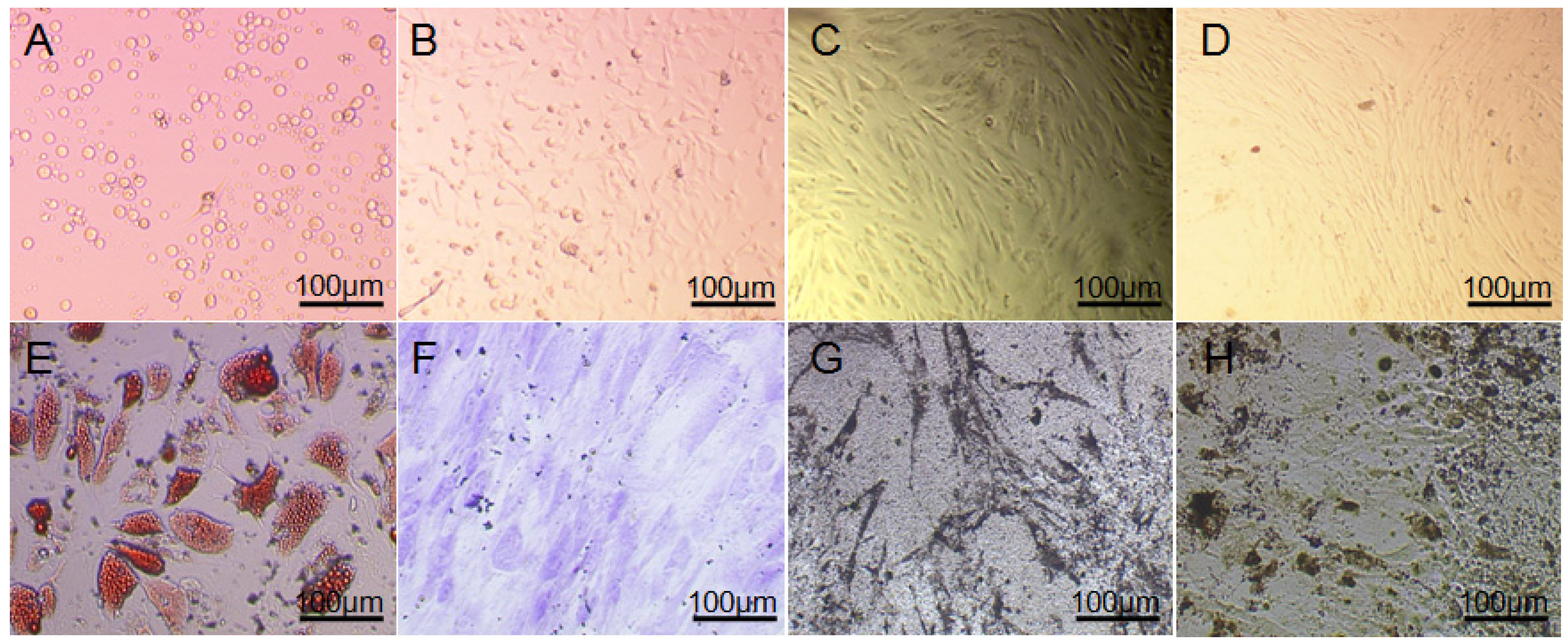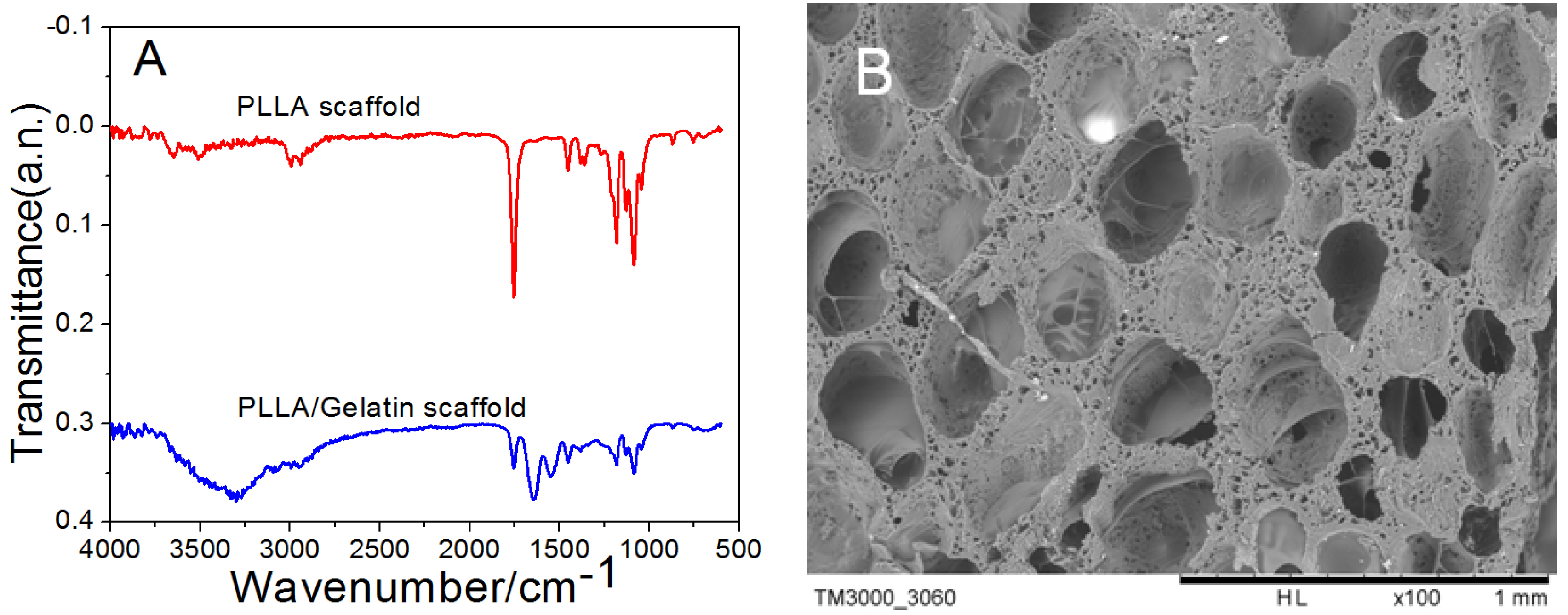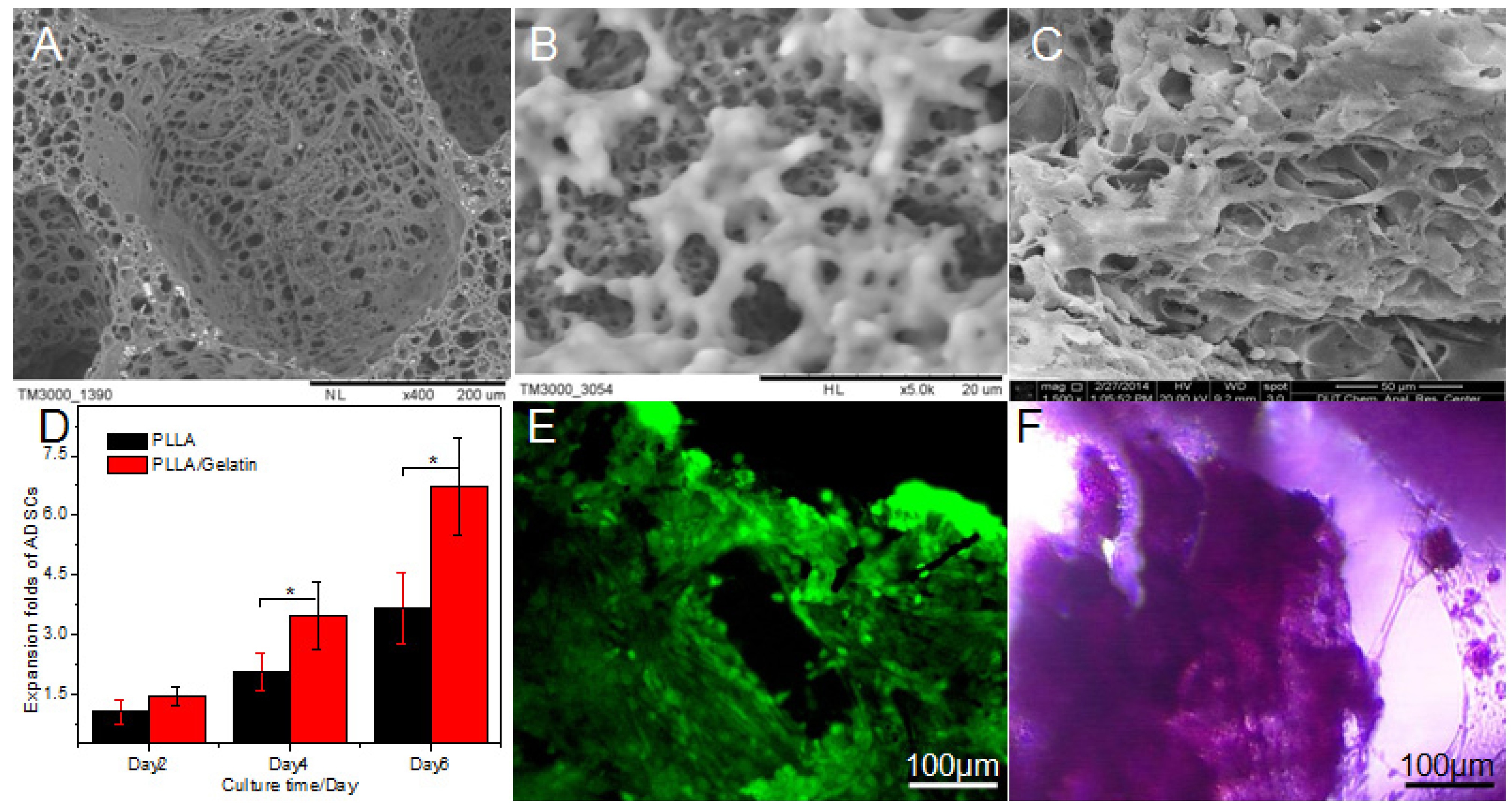Fabrication and Cell Responsive Behavior of Macroporous PLLA/Gelatin Composite Scaffold with Hierarchical Micro-Nano Pore Structure
Abstract
:1. Introduction
2. Results and Discussion
Cellular Morphology




3. Experimental Section
3.1. Isolation and Culture of hADSCs
3.2. Cell Morphology and Multiple Differentiation Potential of ADSCs
3.3. Laser Confocal Microscopy Examination
3.4. Preparation of PLLA Scaffold
3.5. Modification of PLLA Scaffold
3.6. IR Spectra Analysis
3.7. Morphology Observation and Detection by SEM
3.8. Statistical Analysis
4. Conclusions
Acknowledgments
Author Contributions
Conflicts of Interest
References
- Langer, R.; Vacanti, J.P. Tissue engineering. Science 1993, 260, 920–926. [Google Scholar] [CrossRef] [PubMed]
- Song, K.; Liu, T.; Cui, Z.; Li, X.; Ma, X. Three-dimensional fabrication of engineered bone with human bio-derived bone scaffolds in a rotating wall vessel bioreactor. J. Biomed. Mater. Res. A 2008, 86, 323–332. [Google Scholar] [CrossRef] [PubMed]
- Song, K.; Yang, Z.; Liu, T.; Zhi, W.; Li, X.; Deng, L.; Cui, Z.; Ma, X. Fabrication and detection of tissue-engineered bones with bio-derived scaffolds in a rotating bioreactor. Biotechnol. Appl. Biochem. 2006, 45, 65–74. [Google Scholar] [CrossRef] [PubMed]
- Ciapetti, G.; Granchi, D.; Baldini, N. The combined use of mesenchymal stromal cells and scaffolds for bone repair. Curr. Pharm. Des. 2012, 18, 1796–1820. [Google Scholar] [CrossRef] [PubMed]
- Myeroff, C.; Archdeacon, M. Autogenous bone graft: Donor sites and techniques. J. Bone Jt. Surg. 2011, 93, 2227–2236. [Google Scholar] [CrossRef]
- Hopley, E.L.; Salmasi, S.; Kalaskar, D.M.; Seifalian, A.M. Carbon nanotubes leading the way forward in new generation 3D tissue engineering. Biotechnol. Adv. 2014, 32, 1000–1014. [Google Scholar] [CrossRef] [PubMed]
- Song, K.; Wang, H.; Wang, H.; Wang, L.; Qiao, M.; Wu, S.; Liu, T. Investigation of the effective action distance between hematopoietic stem/progenitor cells and human adipose-derived stem cells during their in vitro co-culture. Appl. Biochem. Biotechnol. 2011, 165, 776–784. [Google Scholar] [CrossRef]
- Zhu, Y.; Liu, T.; Ye, H.; Song, K.; Ma, X.; Cui, Z. Enhancement of adipose-derived stem cell differentiation in scaffolds with IGF-I gene impregnation under dynamic microenvironment. Stem Cells Dev. 2010, 19, 1547–1556. [Google Scholar] [CrossRef] [PubMed]
- Buckingham, E.D. Poly-l-lactic acid facial rejuvenation: An alternative to autologous fat? Facial Plast. Surg. Clin. N. Am. 2013, 21, 271–284. [Google Scholar] [CrossRef]
- Santoro, M.; Tatara, A.M.; Mikos, A.G. Gelatin carriers for drug and cell delivery in tissue engineering. J. Control. Release 2014, 190, 210–218. [Google Scholar] [CrossRef] [PubMed]
- Shi, C.; Yuan, W.; Khan, M.; Li, Q.; Feng, Y.; Yao, F.; Zhang, W. Hydrophilic PCU scaffolds prepared by grafting PEGMA and immobilizing gelatin to enhance cell adhesion and proliferation. Mater. Sci. Eng. C Mater. Biol. Appl. 2015, 50, 201–209. [Google Scholar] [CrossRef] [PubMed]
- Fauzi, I.; Panoskaltsis, N.; Mantalaris, A. Early exposure of murine embryonic stem cells to hematopoietic cytokines differentially directs definitive erythropoiesis and cardiomyogenesis in alginate hydrogel three-dimensional cultures. Stem Cells Dev. 2014, 23, 2720–2729. [Google Scholar] [CrossRef] [PubMed]
- Hwang, Y.S.; Randle, W.L.; Bielby, R.C.; Polak, J.M.; Mantalaris, A. Enhanced derivation of osteogenic cells from murine embryonic stem cells after treatment with HepG2-conditioned medium and modulation of the embryoid body formation period: Application to skeletal tissue engineering. Tissue Eng. 2006, 12, 1381–1392. [Google Scholar] [CrossRef] [PubMed]
- Malinen, M.M.; Kanninen, L.K.; Corlu, A.; Isoniemi, H.M.; Lou, Y.R.; Yliperttula, M.L.; Urtti, A.O. Differentiation of liver progenitor cell line to functional organotypic cultures in 3D nanofibrillar cellulose and hyaluronan-gelatin hydrogels. Biomaterials 2014, 35, 5110–5121. [Google Scholar] [CrossRef] [PubMed] [Green Version]
- Song, K.D.; Liu, T.Q.; Li, X.Q.; Cui, Z.F.; Sun, X.Y.; Ma, X.H. Three-dimensional expansion: In suspension culture of SD rat’s in a rotating wall vessel bioreactor. Biomed. Environ. Sci. 2007, 20, 91–98. [Google Scholar] [PubMed]
© 2015 by the authors; licensee MDPI, Basel, Switzerland. This article is an open access article distributed under the terms and conditions of the Creative Commons Attribution license (http://creativecommons.org/licenses/by/4.0/).
Share and Cite
Song, K.; Ji, L.; Zhang, J.; Wang, H.; Jiao, Z.; Mayasari, L.; Fu, X.; Liu, T. Fabrication and Cell Responsive Behavior of Macroporous PLLA/Gelatin Composite Scaffold with Hierarchical Micro-Nano Pore Structure. Nanomaterials 2015, 5, 415-424. https://doi.org/10.3390/nano5020415
Song K, Ji L, Zhang J, Wang H, Jiao Z, Mayasari L, Fu X, Liu T. Fabrication and Cell Responsive Behavior of Macroporous PLLA/Gelatin Composite Scaffold with Hierarchical Micro-Nano Pore Structure. Nanomaterials. 2015; 5(2):415-424. https://doi.org/10.3390/nano5020415
Chicago/Turabian StyleSong, Kedong, Lili Ji, Jingying Zhang, Hai Wang, Zeren Jiao, Lim Mayasari, Xiaoyan Fu, and Tianqing Liu. 2015. "Fabrication and Cell Responsive Behavior of Macroporous PLLA/Gelatin Composite Scaffold with Hierarchical Micro-Nano Pore Structure" Nanomaterials 5, no. 2: 415-424. https://doi.org/10.3390/nano5020415




